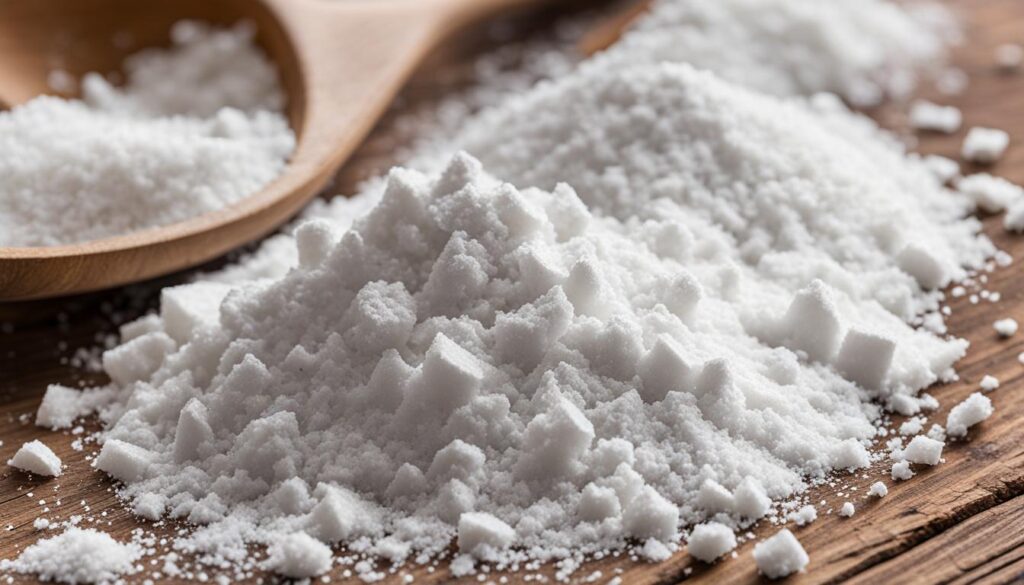Magnesium hydroxide, pronounced as (mag nee’ zee um) (hye drox’ ide), is a versatile compound with numerous applications. It is widely used in medicine and personal care products, as well as in culinary and household settings. Understanding the uses and benefits of magnesium hydroxide can help individuals make informed decisions about its usage.
Key Takeaways:
- Magnesium hydroxide is commonly used as a saline laxative to treat occasional constipation in both children and adults.
- It is also used as an antacid to relieve symptoms of heartburn, acid indigestion, and upset stomach.
- In culinary applications, magnesium hydroxide serves as a food additive, pH adjuster, and natural source of dietary magnesium.
- Magnesium hydroxide has personal care uses, including skincare products, deodorants, and natural odor absorbers.
- Topically, magnesium hydroxide can be used to soothe skin irritation and alleviate symptoms of insect bites.
Culinary Uses of Magnesium Hydroxide

Magnesium hydroxide, also known as milk of magnesia, has several culinary uses and is commonly used as a food additive. Its versatility and unique properties make it a popular choice in food preparation and cooking. Here are some of the key culinary uses of magnesium hydroxide:
- Buffering Agent: Magnesium hydroxide acts as a buffering agent, helping to maintain the pH balance in processed foods. It can be found in a wide range of products, including baking powder, cake mixes, and pickled vegetables.
- Natural Source of Magnesium: Magnesium hydroxide contains approximately 42% elemental magnesium, making it a natural source of this essential mineral. Incorporating magnesium hydroxide into your culinary creations can help boost your dietary intake of magnesium.
- pH Adjuster: Due to its alkaline properties, magnesium hydroxide can be used to adjust the pH of certain food products. It can help enhance the flavors and textures of various dishes, giving them a well-balanced and appealing taste.
“Magnesium hydroxide is a versatile culinary ingredient, playing a vital role in maintaining the pH balance of processed foods and providing a natural source of dietary magnesium.”
However, it is important to note that excessive consumption of magnesium hydroxide can have a laxative effect and may cause gastrointestinal discomfort. Therefore, it is recommended to use it in moderation and follow the recommended dosage guidelines.
Culinary Tips for Using Magnesium Hydroxide:
When incorporating magnesium hydroxide into your culinary creations, consider the following tips:
- Follow the recommended dosage guidelines provided by the manufacturer or recipe.
- Be mindful of the overall flavor profile of your dish and adjust the amount of magnesium hydroxide accordingly.
- If you are using a recipe that calls for baking powder, check the ingredients to see if it already contains magnesium hydroxide.
- Experiment with different culinary applications to explore the versatility of magnesium hydroxide in cooking and food preparation.
By using magnesium hydroxide in your culinary endeavors, you can add a unique twist to your dishes while also reaping the benefits of this essential mineral.
| Culinary Uses of Magnesium Hydroxide |
|---|
| Buffering agent in processed foods, such as baking powder, cake mixes, and pickled vegetables |
| Natural source of dietary magnesium |
| pH adjuster for flavor enhancement |
Personal Care and Household Uses of Magnesium Hydroxide
Magnesium hydroxide has a wide range of applications in both personal care and household settings. Its versatile properties make it a valuable ingredient in various skincare products and household items.
Skincare
In skincare, magnesium hydroxide is commonly used for its moisturizing and skin conditioning benefits. It can be found in lotions, creams, and other topical formulations, helping to soothe and nourish the skin.
I love using skincare products infused with magnesium hydroxide because it leaves my skin feeling hydrated and supple. It’s gentle yet effective, making it suitable for all skin types.
Deodorants and Antiperspirants
Magnesium hydroxide is also utilized in deodorants and antiperspirants due to its ability to neutralize odor-causing bacteria. It provides a natural and effective alternative to aluminum-based compounds, which are sometimes associated with health concerns.
- Keeps you feeling fresh throughout the day
- Does not block sweat glands
- Gentle on the skin
Natural Odor Absorber
Aside from personal care products, magnesium hydroxide can also be used as a natural odor absorber in household items. It helps eliminate unpleasant smells in shoes, refrigerators, or other confined spaces.
The use of magnesium hydroxide as a natural odor absorber has transformed my household. No more lingering odors in the kitchen or funky smells in my shoes!
Whether it’s enhancing skincare routines, providing odor protection, or freshening up our living spaces, magnesium hydroxide proves to be a versatile ingredient with various personal care and household uses.
Topical Uses of Magnesium Hydroxide

Magnesium hydroxide has a range of topical uses that make it a versatile ingredient in skincare products. Its soothing properties make it an excellent choice for relieving skin irritation and promoting skin health.
One of the key topical uses of magnesium hydroxide is for skin irritation. Whether it’s a rash, sunburn, or other forms of skin irritation, applying magnesium hydroxide can help alleviate redness, inflammation, and discomfort. Its gentle and calming effect can provide relief and promote the healing process.
In addition to skin irritation, magnesium hydroxide can also be used to soothe insect bites. The anti-inflammatory properties of magnesium hydroxide help reduce itching and inflammation caused by insect bites, providing quick relief and preventing further discomfort.
Magnesium hydroxide is often found in skincare products designed to soothe and calm the skin. These products can come in various forms such as creams, lotions, or ointments. They are formulated to deliver the benefits of magnesium hydroxide and other soothing ingredients directly to the skin, providing relief from irritation, redness, and dryness.
When using skincare products containing magnesium hydroxide, it is important to follow the instructions provided by the manufacturer. Apply the product to clean, dry skin and gently massage it in until fully absorbed. If any irritation or adverse reaction occurs, discontinue use and consult a healthcare professional.
Benefits of Using Magnesium Hydroxide Topically:
- Relieves skin irritation such as rashes and sunburns
- Soothes inflammation and itching caused by insect bites
- Calms and moisturizes the skin
- Promotes skin healing
Overall, magnesium hydroxide is a valuable ingredient in skincare products due to its soothing properties. Whether used as a standalone ingredient or in combination with other beneficial ingredients, it can provide relief and promote healthy, radiant skin.
| Advantages | Disadvantages |
|---|---|
| Gentle and safe for most skin types | Avoid if allergic to magnesium or any other ingredients |
| Reduces redness and inflammation | May cause temporary skin dryness in some individuals |
| Can be used for various skin conditions | Not a substitute for medical treatment |
| Promotes skin healing | Individual results may vary |
Benefits and Applications of Magnesium Hydroxide

Magnesium hydroxide offers various benefits and has a wide range of applications. It is particularly beneficial for digestive health and provides relief from common issues such as acid reflux, heartburn, and indigestion. Its mechanism of action involves neutralizing excess stomach acid, reducing discomfort, and promoting overall digestive well-being.
One of the key applications of magnesium hydroxide is its effectiveness in treating occasional constipation. Its gentle laxative effect helps promote regular bowel movements and alleviate discomfort without causing harsh side effects. As a natural alternative to synthetic laxatives, magnesium hydroxide offers a safer and more gentle option for relieving constipation.
In addition to its digestive health benefits, magnesium hydroxide plays a significant role in supporting overall well-being. It is an essential mineral that is involved in numerous physiological functions in the body. Magnesium hydroxide helps maintain proper muscle and nerve function, regulates blood pressure, and supports bone health. Incorporating magnesium hydroxide into your daily routine can contribute to the maintenance of a healthy and balanced lifestyle.
When it comes to acid reflux relief, magnesium hydroxide offers a natural solution. By neutralizing excess stomach acid, it helps alleviate the burning sensation and discomfort associated with acid reflux. Many individuals find relief from using magnesium hydroxide as an effective and safe alternative to traditional antacids.
It is essential to note that while magnesium hydroxide provides numerous benefits, it is important to use it responsibly and follow the recommended dosage instructions. Consulting a healthcare professional is advised, especially if symptoms persist or if you have any underlying medical conditions.
Usage Tips and Cautions for Magnesium Hydroxide

When using magnesium hydroxide, it is important to follow the recommended dosage instructions. Taking more than the recommended dose can lead to abdominal discomfort and excessive bowel movements.
It is also advised not to use magnesium hydroxide for more than 1 week without consulting a doctor. If symptoms persist or worsen, medical advice should be sought.
Individuals with kidney disease or a magnesium-restricted diet should consult a healthcare professional before using magnesium hydroxide.
Side effects of magnesium hydroxide may include loose stools or diarrhea. In rare cases, high magnesium levels can occur, resulting in symptoms such as muscle weakness, slow heartbeat, and mental/mood changes. It is important to report any unusual or severe symptoms to a healthcare provider.
Magnesium hydroxide may interact with certain medications, such as antibiotics and antifungals, so it is important to discuss all current medications with a healthcare professional before starting magnesium hydroxide.
Dosage Guidelines
It is crucial to adhere to the recommended dosage guidelines when taking magnesium hydroxide. The appropriate dosage may vary depending on the specific product and intended use. Always follow the instructions provided by the manufacturer or healthcare professional.
Typically, for constipation relief, adults can take 2 to 6 teaspoons (10 to 30 ml) of magnesium hydroxide liquid orally, diluted in water, once a day. Children aged 6 to 11 years can take 1 to 2 teaspoons (5 to 10 ml) once a day, while those aged 2 to 5 years can take 1/2 to 1 teaspoon (2.5 to 5 ml) once a day. However, it is essential to check the dosage instructions of the specific product.
For antacid use, the dosage can vary. It is recommended to take the antacid form of magnesium hydroxide as directed by a healthcare professional or according to the instructions on the packaging.
It is crucial not to exceed the recommended dosage to avoid potential side effects.
Precautions and Potential Side Effects
Magnesium hydroxide is usually safe for short-term use when taken at the correct dosage. However, certain precautions should be observed:
- Avoid using magnesium hydroxide for more than 1 week without consulting a healthcare professional.
- Individuals with kidney disease or a magnesium-restricted diet should consult a healthcare professional before using magnesium hydroxide.
- Report any unusual or severe symptoms, such as muscle weakness, slow heartbeat, or mental/mood changes, to a healthcare provider.
Possible side effects of magnesium hydroxide may include:
- Loose stools or diarrhea
- Abdominal discomfort
If these side effects persist or worsen, it is advisable to seek medical advice.
Interactions with Medications
Magnesium hydroxide may interact with certain medications, potentially affecting their effectiveness or causing adverse reactions. It is essential to inform healthcare professionals about all current medications, including prescriptions, over-the-counter drugs, and herbal supplements before starting magnesium hydroxide.
Medications that may interact with magnesium hydroxide include:
- Antibiotics
- Antifungals
- Digoxin
- Iron supplements
- Calcium channel blockers
A healthcare professional can provide guidance on potential interactions and recommend appropriate adjustments to medication regimens if necessary.
Summary
Proper usage and precautions are crucial when using magnesium hydroxide. Follow the recommended dosage instructions, consult a healthcare professional for personalized advice, and report any unusual symptoms or interactions with other medications. By using magnesium hydroxide responsibly, it can be a safe and effective solution for relieving occasional constipation and managing symptoms of heartburn or acid reflux.
Selecting the Best Quality Magnesium Hydroxide

When it comes to finding high-quality Magnesium Hydroxide products, selecting the best is essential for optimal results and safety. Here are some key tips to help you choose the best quality Magnesium Hydroxide:
1. Look for reputable brands and manufacturers
One of the first things to consider is the brand and manufacturer of the Magnesium Hydroxide product. Opt for well-known brands with a trusted reputation in the industry. Reputable manufacturers often adhere to strict quality control measures, ensuring the highest standards in their products.
2. Read customer reviews
A great way to gauge the quality and effectiveness of Magnesium Hydroxide products is by reading customer reviews. Genuine customer feedback can provide valuable insights into the product’s performance, customer satisfaction, and any potential issues or side effects that others may have experienced.
3. Check the product’s ingredients and manufacturing processes
Take the time to review the product’s ingredients and manufacturing processes. Ensure that the Magnesium Hydroxide product meets your specific needs and requirements. Look for products that are free from unnecessary additives or fillers and are manufactured using safe and ethical practices.
4. Ensure compliance with industry standards and regulations
It is important to choose Magnesium Hydroxide products that are manufactured in accordance with industry standards and regulations. This ensures that the product has undergone rigorous testing and meets specific quality and safety criteria. Look for certifications or approvals from regulatory bodies or organizations that validate the product’s quality and efficacy.
5. Seek guidance from healthcare professionals
If you are uncertain about which Magnesium Hydroxide product to choose, it is always a good idea to consult with a healthcare professional or pharmacist. They can provide personalized guidance and recommendations based on your individual health needs and any potential interactions with other medications or conditions.
By following these tips, you can confidently select the best quality Magnesium Hydroxide products that meet your specific requirements and ensure optimal effectiveness and safety.
Proper Storage of Magnesium Hydroxide

Proper storage is crucial to maintain the effectiveness and quality of magnesium hydroxide. Follow these guidelines to ensure optimal storage conditions:
- Keep the medication in its original container to preserve its integrity and protect it from external factors.
- Tightly close the container to prevent air and moisture from entering, which could affect the stability of the product.
- Store magnesium hydroxide in a cool, dry place at room temperature. Avoid exposure to excessive heat or direct sunlight.
- Keep the medication out of reach of children to prevent accidental ingestion.
- Avoid storing magnesium hydroxide in the bathroom, as high humidity can accelerate degradation.
If you have the suspension form of magnesium hydroxide, remember to shake it well before each use to ensure proper mixing of the ingredients.
It is essential to follow the storage instructions provided with the specific product, as different brands may have slight variations in storage requirements.
Recommended Storage Conditions for Magnesium Hydroxide
| Storage Condition | Recommendation |
|---|---|
| Container | Original container |
| Closure | Tightly closed |
| Temperature | Room temperature |
| Humidity | Avoid excessive moisture |
| Light | Avoid direct sunlight |
| Accessibility | Out of reach of children |
| Location | Avoid storing in the bathroom |
Proper storage ensures that magnesium hydroxide remains safe, effective, and ready for use whenever needed.
History and Origin of Magnesium Hydroxide

Magnesium hydroxide, a substance known for its laxative properties, has a long and storied history that dates back centuries. Its origins can be traced to the mineral magnesite, which is a naturally occurring source of magnesium. Ancient civilizations recognized the therapeutic effects of magnesium hydroxide on the digestive system, and it was used as both an antacid and a laxative.
Over time, the use of magnesium hydroxide continued to evolve and its effectiveness and safety were studied and confirmed. Today, it is widely used in modern medicine and personal care products for its various applications. With its rich history and proven track record, magnesium hydroxide remains a trusted ingredient in the healthcare and wellness industry.
In ancient times, different cultures discovered the benefits of magnesium hydroxide for digestive health. The Egyptians and Greeks, for instance, used magnesium hydroxide as a laxative to treat constipation. It was also used as an antacid to relieve symptoms of heartburn and indigestion.
“The use of magnesium hydroxide as an antacid and laxative can be traced back to ancient civilizations, where it was recognized for its therapeutic effects on the digestive system.”
Fast forward to the present day, and magnesium hydroxide continues to be a vital component in various medications and personal care products. It is widely used as an active ingredient in over-the-counter antacids, laxatives, and skincare products due to its ability to alleviate digestive discomfort and promote healthy skin.
| Benefits of Magnesium Hydroxide | Applications of Magnesium Hydroxide |
|---|---|
|
|
Magnesium hydroxide’s history and effectiveness have made it a valuable resource in various fields. From its ancient origins to its present-day applications, this compound continues to play a significant role in promoting digestive health and well-being.
Key Components and Properties of Magnesium Hydroxide
Magnesium hydroxide, chemical formula Mg(OH)2, is a white, crystalline powder composed of magnesium and hydroxide ions. It is an odorless substance with a slightly bitter taste. The chemical composition of magnesium hydroxide consists of one magnesium atom bonded to two hydroxide ions.
One of the key properties of magnesium hydroxide is its high pH, which makes it alkaline in nature. This alkalinity gives it the ability to neutralize excess stomach acid, making it an effective antacid for relieving heartburn, acid indigestion, and upset stomach.
Magnesium hydroxide has strong alkaline properties due to its chemical structure. It is often used in the form of an oral suspension or tablets because of its low solubility in water. This allows for easier administration and ensures that the desired effects are achieved.
FAQ
What are the uses of Magnesium Hydroxide?
Magnesium Hydroxide is commonly used as a saline laxative for constipation relief and as an antacid for heartburn and indigestion. It also has culinary, personal care, and topical applications.
How does Magnesium Hydroxide work as a laxative?
Magnesium Hydroxide works by increasing water retention in the stool, leading to more frequent bowel movements and softer stools.
What forms does Magnesium Hydroxide come in?
Magnesium Hydroxide is available in forms such as chewable tablets, regular tablets, and liquid suspension.
How long does it take for Magnesium Hydroxide to produce a bowel movement?
Magnesium Hydroxide can typically produce a bowel movement within 30 minutes to 6 hours after ingestion.
Can I use Magnesium Hydroxide long-term?
It is generally safe for short-term use. However, if symptoms persist for more than a week or if any side effects occur, it is important to consult a doctor.
What are the culinary uses of Magnesium Hydroxide?
Magnesium Hydroxide is used as a buffering agent and pH adjuster in processed foods, including baking powder, cake mixes, and pickled vegetables. It can also be used as a natural source of dietary magnesium.
What personal care and household products contain Magnesium Hydroxide?
Magnesium Hydroxide is found in skincare products such as lotions and creams, deodorants, and antiperspirants. It can also be used as a natural odor absorber in household items.
How can Magnesium Hydroxide be used topically?
Magnesium Hydroxide can be applied directly to the skin to soothe irritations, such as rashes, sunburns, itching, and inflammation caused by insect bites.
What are the benefits of using Magnesium Hydroxide?
Magnesium Hydroxide can help relieve symptoms of acid reflux, heartburn, indigestion, and occasional constipation. It also supports overall health and well-being.
What should I be cautious of when using Magnesium Hydroxide?
It is important to follow the recommended dosage instructions and not exceed the recommended dose. Individuals with kidney disease or a magnesium-restricted diet should consult a healthcare professional before using Magnesium Hydroxide.
How do I select the best quality Magnesium Hydroxide?
Choose products from reputable brands and manufacturers. Read customer reviews, check the product’s ingredients and manufacturing processes, and ensure it is manufactured in accordance with industry standards and regulations.
How should Magnesium Hydroxide be stored?
It is recommended to keep Magnesium Hydroxide in its original container, tightly closed, at room temperature, away from excessive heat and moisture. Avoid storing it in the bathroom.
What is the history and origin of Magnesium Hydroxide?
Magnesium Hydroxide has been used for centuries and can be traced back to ancient civilizations for its therapeutic effects on the digestive system.
What are the key components and properties of Magnesium Hydroxide?
Magnesium Hydroxide is a chemical compound made up of magnesium and hydroxide ions. Its chemical formula is Mg(OH)2. It is a white, crystalline powder with alkaline properties and low solubility in water.






